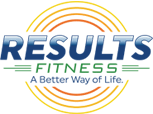Rowing Machine Workout: Top 5 Ultimate Benefits
Why Rowing Machine Workouts Are Your Secret Weapon for Total Fitness
Rowing machine workout routines offer one of the most efficient ways to transform your entire body while torching calories. If you’re looking for a complete fitness solution, here’s what makes rowing so powerful:
Key Benefits of Rowing Machine Workouts:
- Full-body engagement – Works 86% of your muscles in every stroke
- High calorie burn – Burns 369 calories in 30 minutes for a 155-pound person
- Low-impact – Easy on joints while delivering intense cardio
- Time-efficient – Effective workouts in just 10-20 minutes
- Versatile – Perfect for beginners through advanced athletes
Essential Workout Types:
- Steady-state rowing – 20-30 minutes at moderate intensity
- HIIT intervals – Alternating high and low intensity bursts
- Sprint workouts – Short, maximum-effort sessions
Research shows that rowing engages major muscle groups throughout your entire body – arms, back, chest, core, legs, and glutes – with every single stroke. The CDC recommends 30 minutes of moderate aerobic activity daily, and rowing machines can be used 4-6 times per week to meet these guidelines.
Unlike high-impact exercises that stress your joints, rowing provides a smooth, controlled movement that’s incredibly joint-friendly. Harvard Health found that vigorous rowing burns more calories in 30 minutes than 17 other gym activities, making it extremely efficient for weight loss and cardiovascular fitness.
I’m Jennifer Rapchak, Fitness Director at Results Fitness Alexandria, with over 14 years of experience as a certified personal trainer specializing in HIIT and strength training. Throughout my career, I’ve helped countless members master rowing machine workout techniques to achieve their fitness goals efficiently and safely.
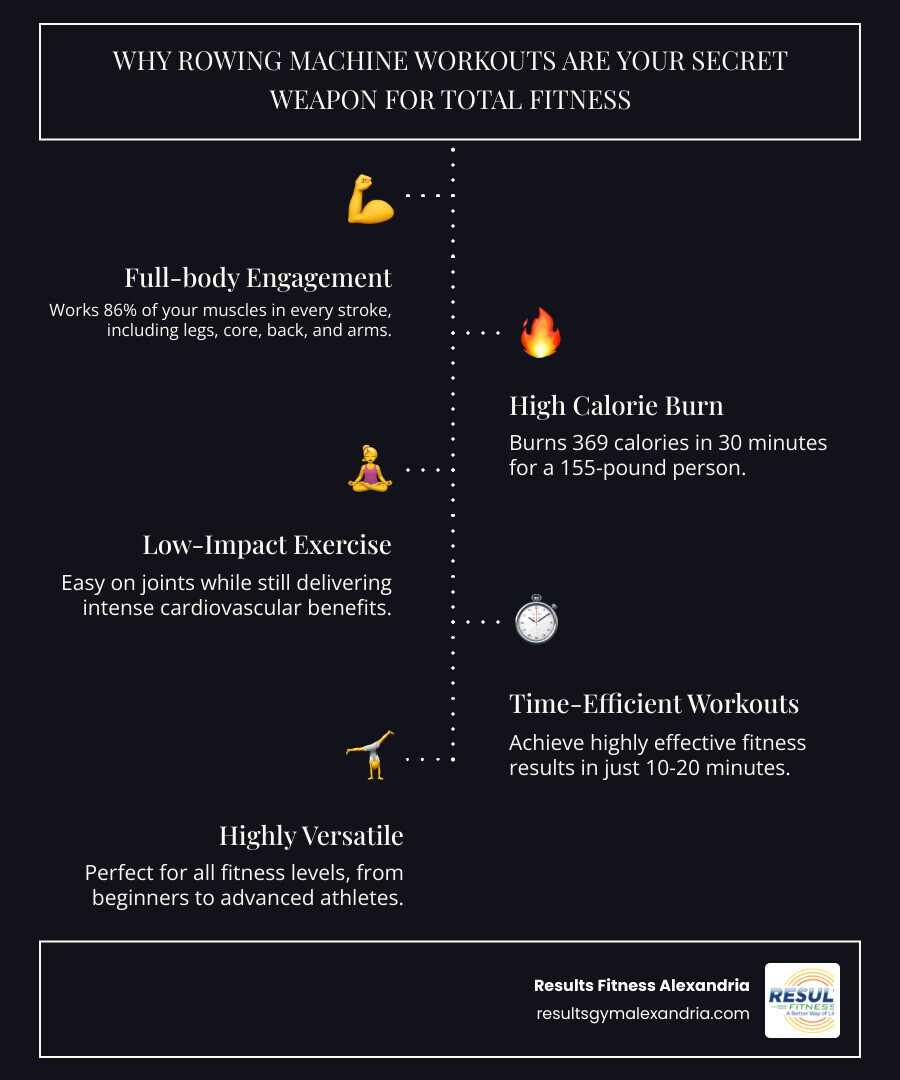
Must-know Rowing machine workout terms:
The Unrivaled Benefits of Rowing
Picture this: you’re looking for a workout that hits almost every muscle in your body, burns serious calories, and doesn’t beat up your joints. Sound too good to be true? That’s exactly what a rowing machine workout delivers, and honestly, it’s pretty amazing when you break down what’s actually happening.
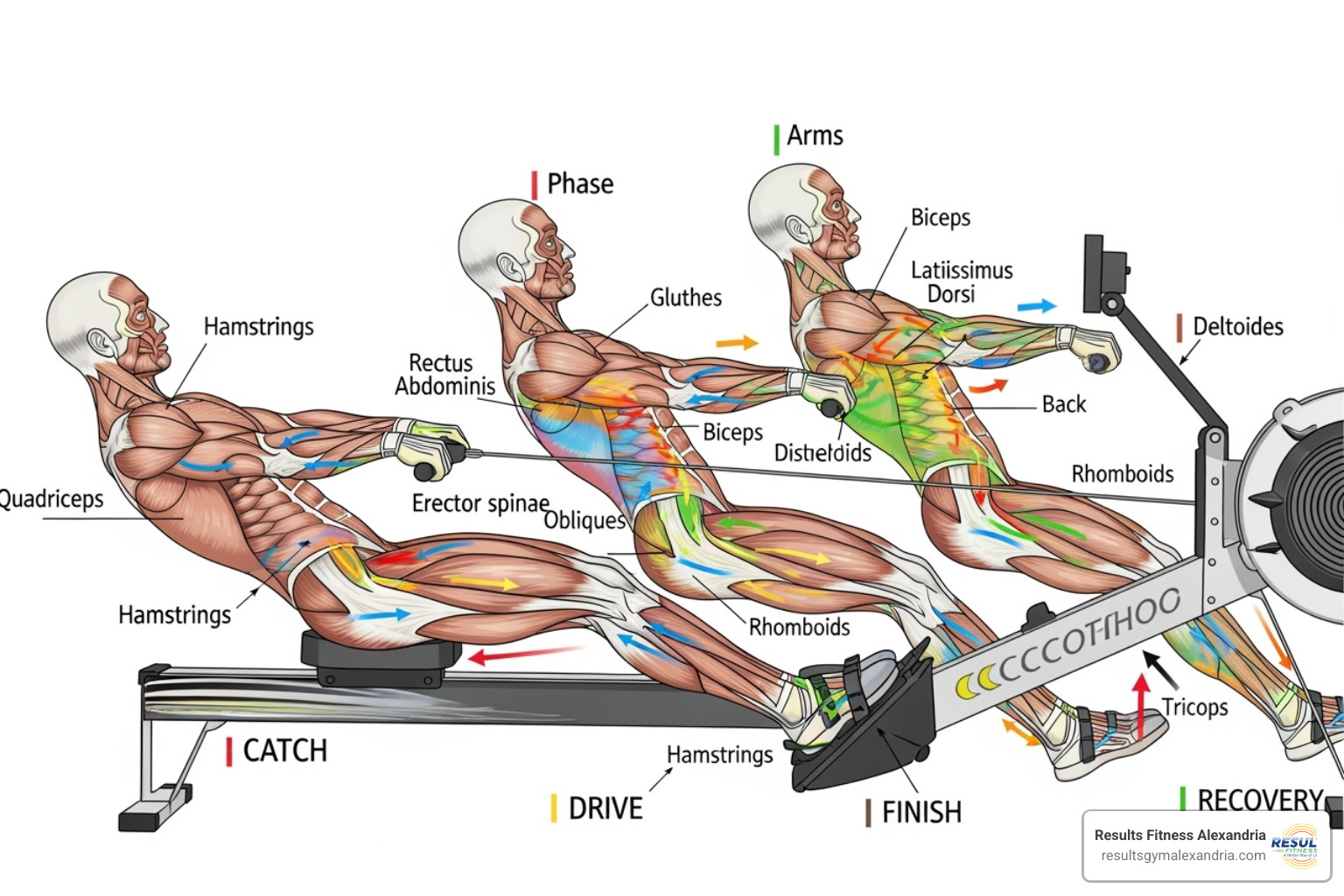
Here’s the thing that blows most people away: rowing engages 86% of your muscles with every single stroke. I know that sounds like gym marketing speak, but it’s actually backed by science. Your legs fire first – those powerful quads, hamstrings, glutes, and calves drive the movement. Then your core kicks in, working overtime to stabilize your body and transfer all that power through your torso.
Your back muscles – the lats, rhomboids, and middle traps – pull the handle toward your body, while your arms finish the stroke with your biceps and shoulders. This incredible chain reaction means you’re building what we call your posterior chain – basically the entire back side of your body that keeps you standing tall and strong.
When it comes to your heart, rowing doesn’t mess around. Research shows that just 20 minutes of rowing, three times a week, can significantly boost your cardiovascular health. We’re talking about real improvements in your VO2 max (how efficiently your body uses oxygen), lower blood pressure, and better cholesterol levels. Studies have even found that rowing stimulates your heart muscle more effectively than cycling, giving you improved heart health that you can actually feel.
The calorie burn? It’s honestly impressive. According to the Harvard Health study, a 155-pound person torches 369 calories in just 30 minutes of vigorous rowing. That puts it at the top of the list for gym equipment – beating out most other cardio machines for pure calorie-crushing power.
But here’s what I love most about rowing: it’s incredibly joint-friendly. Your feet stay planted, there’s no pounding on pavement, and the smooth gliding motion means your knees, hips, and ankles get a break from impact stress. This makes it perfect for anyone dealing with joint issues or just wanting to build cardio stamina without the wear and tear.
As a bonus, regular rowing actually helps improve your bone density over time. That’s huge for long-term health, especially as we get older and want to stay strong and active. It’s like getting a strength workout and cardio session rolled into one smooth, efficient movement.
Mastering the Stroke: Proper Form and Common Mistakes
Think of rowing as a beautiful dance between power and precision. To get the most out of your rowing machine workout and stay injury-free, you need to master the four-phase movement that transforms your entire body into one coordinated machine.
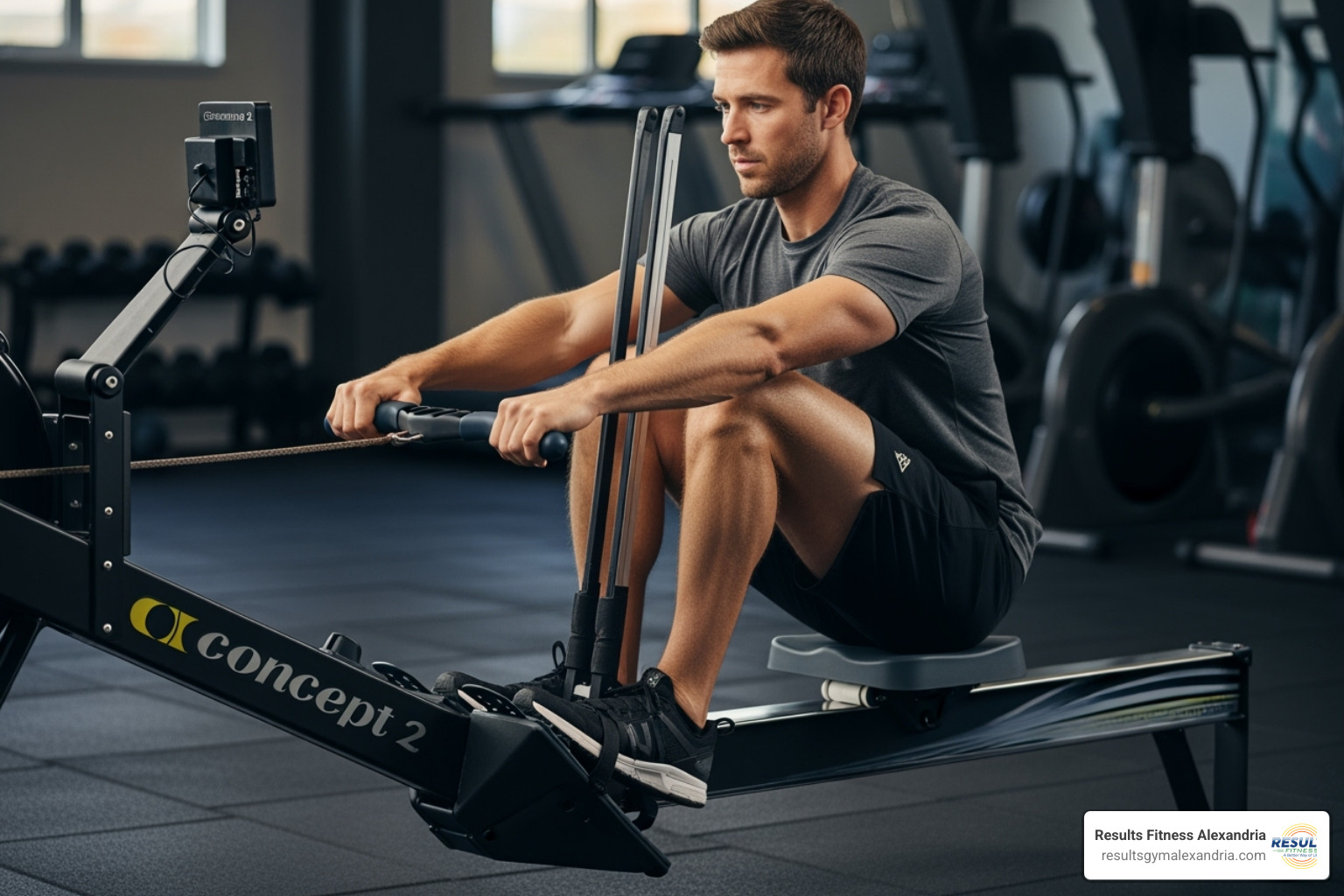
Let me walk you through each phase of the rowing stroke, because getting this right will make all the difference in your results.
The Catch is where it all begins. Picture yourself coiled like a spring, ready to explode with power. Your knees are bent, shins nearly vertical, and your body leans slightly forward from the hips. Your arms stretch fully toward the flywheel, core engaged, shoulders relaxed. This position might feel a bit awkward at first, but it’s setting you up for maximum power transfer.
The Drive is where the magic happens, and here’s the secret: your legs do most of the work! Push powerfully through your heels first, extending those legs like you’re jumping. As your legs straighten, lean back slightly to about 11 o’clock, then pull the handle smoothly to your sternum. Remember the sequence: legs, then body, then arms. This proper sequencing ensures you’re using your strongest muscles first.
The Finish finds you with legs fully extended, body leaned back comfortably, and the handle pulled to your sternum with elbows pointing back. Your core stays engaged throughout, acting as the bridge that transfers all that leg power up through your body. Keep those shoulders down and relaxed – no hunching!
The Recovery is the calm after the storm, and rushing it is one of the biggest mistakes I see. Reverse everything smoothly: arms extend first until they clear your knees, then hinge forward from your hips, finally bending your knees to glide back to the catch. Think of a 1:2 timing ratio – one count for the powerful drive, two counts for the controlled recovery.
Your legs are the true powerhouse here, generating about 60% of your stroke’s force. Your core contributes 20%, while your arms and back add the final 20%. When you engage your core properly, imagine bracing for a gentle punch – this protects your lower back while maximizing power transfer.
Now, let’s talk about the mistakes that can sabotage your rowing machine workout. Rushing the recovery creates a choppy, inefficient stroke that wastes energy. Hunching your back strains your spine and reduces power – always lean forward from your hips, not by rounding your shoulders. Pulling with arms first bypasses your strongest muscles and leads to quick fatigue and potential injury.
The damper setting confuses many people. It’s not about making your workout “harder” – it controls airflow to the flywheel, mimicking different boat types. Most people thrive with settings between 3-5, which provide smooth, efficient resistance. Higher settings often mean more work for less benefit.
If you’re just starting out, focus on nailing your form before worrying about speed or intensity. Every stroke should feel controlled and purposeful. For more guidance on building a solid foundation, check out our tips on Creating an Effective Workout Routine for Beginners.
Mastering proper rowing technique takes practice, but once you get it right, every rowing machine workout becomes incredibly effective and satisfying. Your body will thank you for taking the time to learn it properly!
Your Ultimate Rowing Machine Workout Plan
Now that we understand the incredible benefits and proper form, let’s dive into how we can structure your rowing machine workout to meet your specific fitness goals. Whether you’re aiming for endurance, strength, or weight loss, the rowing machine is incredibly versatile and adapts beautifully to whatever you’re trying to achieve.
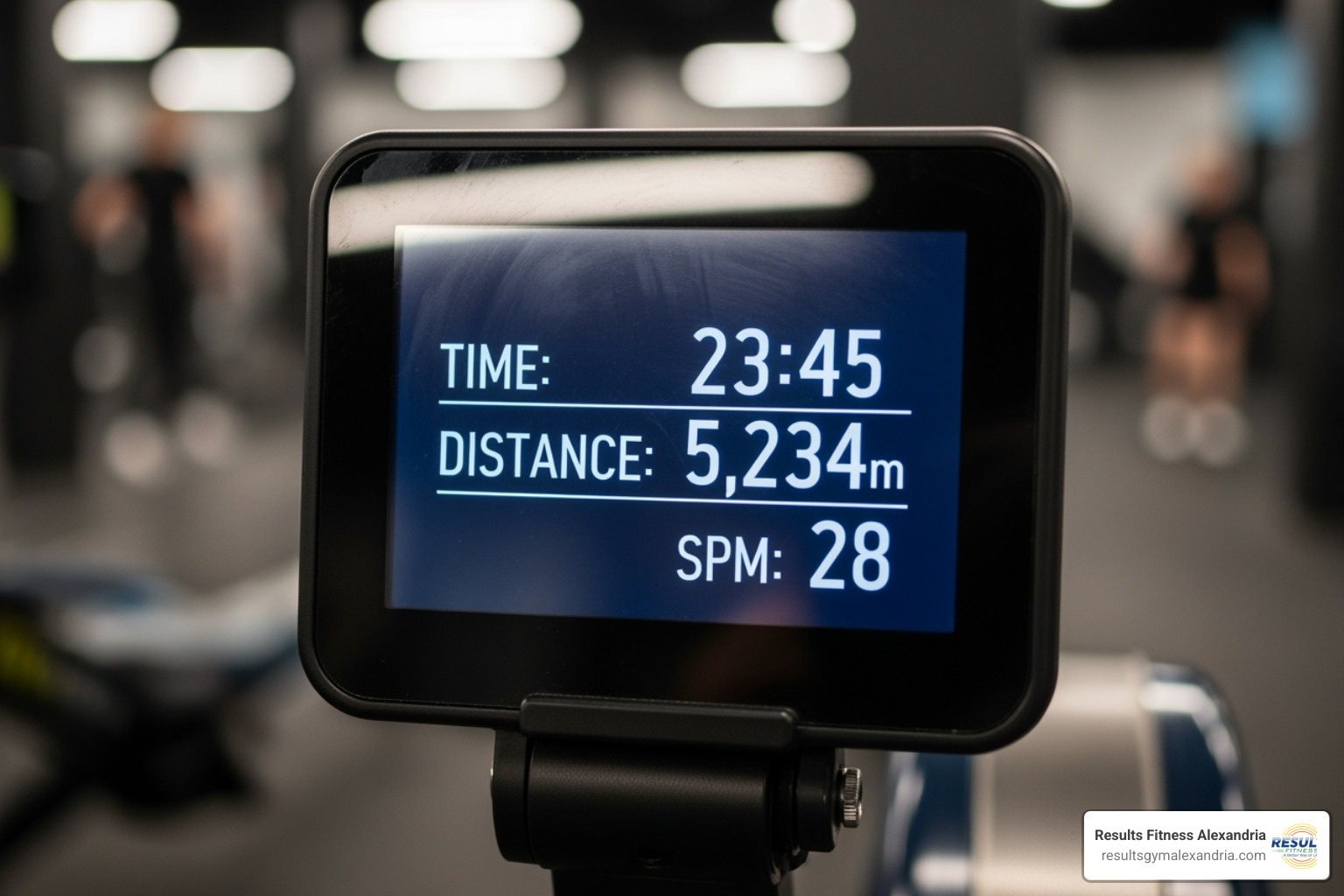
Think of rowing workouts like cooking – you can use the same basic ingredients but create completely different meals depending on your approach. We primarily work with two main workout styles that can transform your fitness journey.
Steady-state cardio is like that reliable friend who’s always there for you. This involves rowing at a consistent, moderate intensity for a longer duration, and it’s absolutely fantastic for building your aerobic endurance and improving cardiovascular health. You should be able to hold a conversation during steady-state rowing, albeit a slightly breathless one! It’s your go-to for burning calories consistently while building that rock-solid fitness foundation.
On the flip side, HIIT (High-Intensity Interval Training) rowing is like that friend who pushes you to try new adventures. This approach alternates short bursts of maximal effort rowing with periods of lower-intensity recovery or complete rest. HIIT is incredibly efficient for burning calories in a shorter amount of time and boosting your metabolism long after you’ve finished sweating. Research shows that HIIT can burn 25% to 30% more calories than non-interval workouts in the same timeframe, and it leads to a higher metabolic rate for several hours after exercise. The science behind HIIT benefits really shows its incredible potential for changing your fitness.
A Beginner Rowing Machine Workout
For those new to rowing, we’re all about building that solid foundation of form and endurance without overwhelming your body. A 20-minute rowing machine workout is the perfect starting point – long enough to feel accomplished, short enough to maintain good form throughout.
Let’s start with a 5-minute warm-up that’s like teaching your body the language of rowing. Begin with 2 minutes of gentle rowing at a very low intensity, focusing entirely on smooth, controlled movements. Then we’ll break down the stroke: spend 1 minute doing arms-only rowing with your legs still and body leaned forward, just pulling with your arms. Follow this with 1 minute of body-only rowing, keeping your legs still while using your core to swing your body back and forth with arms extended. Finish the warm-up with 1 minute of half-slide rowing, where your legs move but only extend halfway while your arms and body follow through.
The 12-minute main set is beautifully simple yet effective. Row for 2 minutes at a moderate pace where you feel challenged but can still maintain excellent form. Then recover for 1 minute with very light, easy rowing that feels almost effortless. Repeat this cycle 4 times, and you’ll be amazed at how your body adapts and grows stronger with each interval.
Your 3-minute cool-down is just as important as the workout itself. Spend these minutes with very light, easy rowing, gradually decreasing intensity until you’re barely moving. Finish with some gentle stretching of your hamstrings, quads, and back – your body will thank you tomorrow!
This routine emphasizes form over speed, and consistency truly is your secret weapon. You’ll be amazed at how quickly your endurance improves when you stick with it. If you’re looking for more beginner-friendly approaches to fitness, our Women’s Beginner Gym Workout offers additional foundational strategies.
HIIT Rowing Machine Workout for Maximum Results
Once you’ve mastered the basics and feel confident with your form, incorporating HIIT can absolutely boost your rowing machine workout. HIIT rowing is fantastic for pushing your limits, boosting calorie burn, and achieving that sought-after “afterburn effect” where your body continues burning calories long after you’ve toweled off.
Our intermediate HIIT workout spans 20 minutes and packs a serious punch. Start with a 5-minute warm-up of moderate rowing, gradually increasing intensity to prepare your body for what’s coming. The 12-minute main set alternates 30 seconds of all-out sprint effort (and we mean everything you’ve got!) with 90 seconds of easy recovery rowing. Repeat this cycle 6 times, and you’ll find muscles you didn’t know you had. Finish with 3 minutes of light rowing and stretching to bring your heart rate back down gracefully.
For those ready to take it up another notch, our advanced HIIT Tabata-style workout is a true game-changer. After your 5-minute moderate rowing warm-up, you’ll tackle 12 minutes of pure intensity. Perform 8 rounds of 20 seconds all-out sprint followed by 10 seconds of rest or very light rowing – this creates one 4-minute Tabata block. Rest for 1 minute between blocks, then repeat for a total of 3 Tabata blocks. It’s challenging, intense, and incredibly rewarding.
With HIIT, when we say “all-out,” we mean giving it absolutely everything you’ve got! Your legs should be driving powerfully, your core engaged, and your heart pumping. It’s tough, but the results are absolutely worth every drop of sweat. If you’re curious about exploring other HIIT approaches, check out Why You Should Give HIIT Exercises a Try.
Tailoring Your Workout
The real beauty of the rowing machine lies in its incredible adaptability to your specific fitness goals. It’s like having a personal trainer that adjusts perfectly to what you need most.
For endurance training, think of yourself as building an engine that can go the distance. Focus on steady-state rowing for 30-60 minutes at a consistent, moderate pace (around 60-70% of your maximum heart rate). Keep your stroke rate consistent, typically between 18-24 strokes per minute, and focus on maintaining your split time – that’s the time it takes to row 500 meters. This approach builds your aerobic base and mental fortitude, creating that steady, reliable fitness foundation. Our guide on Cardio Training for Better Endurance dives deeper into building that cardiovascular powerhouse.
Strength building with rowing focuses on power and explosiveness rather than just endurance. Emphasize powerful, explosive strokes at a lower stroke rate (16-20 strokes per minute) with higher resistance through your damper setting. Incorporate short, intense intervals with longer rest periods to really focus on that muscular power. You can also combine your rowing sessions with functional strength exercises off the machine – think squats, deadlifts, and planks – to complement and improve your rowing power. Understanding What is Functional Strength Training? A Simple Guide can help you integrate these complementary exercises effectively.
For weight loss goals, the magic happens when you combine both steady-state and HIIT rowing approaches. Steady-state rowing helps you burn a significant number of calories over time, building that consistent calorie deficit. Meanwhile, HIIT boosts your metabolism and keeps burning calories long after your workout ends – it’s like getting bonus points for hours after you’re done! Aim for 3-5 rowing sessions per week, varying the intensity and duration to keep your body challenged and engaged.
Exercise is only one part of the weight loss equation. Pairing your rowing machine workout with a healthy, balanced diet creates the foundation for sustainable, long-term results. For more insights on balancing your fitness approach, explore Cardio vs. Strength Training for Weight Loss: Which is Better?.
Frequently Asked Questions about Rowing Workouts
We get tons of questions from our members about rowing, and honestly, I love seeing that curiosity! It means people are ready to dive in and make the most of their fitness journey. Let me share the answers to the questions we hear most often.
How long and how often should I use a rowing machine?
This is probably the most common question I hear, and the answer really depends on where you’re starting from and what you’re hoping to achieve.
If you’re just getting started with rowing machine workout routines, I always recommend beginning with 20-30 minute sessions, three times a week. Your body needs time to learn the movement pattern and build that foundational endurance. Plus, this gives you proper recovery time between sessions, which is when your muscles actually get stronger.
For general fitness maintenance, most of our members do well with 30-45 minute sessions, 3-5 times per week. This fits perfectly with the CDC’s recommendation of 30 minutes of moderate aerobic activity most days. You’ll notice improvements in your cardiovascular health, strength, and endurance with this schedule.
Now, if you’re training for something specific or you’re already quite fit, you might push into 45-60+ minute sessions or row 4-6 times weekly. Advanced rowers often mix steady-state endurance work with high-intensity intervals throughout the week.
Here’s what I always tell my clients: rest days are not optional. Your muscles need time to recover and rebuild. Skipping rest days doesn’t make you tougher; it makes you more likely to get injured or burn out. Listen to your body – it’s smarter than any workout plan.
For more guidance on creating a schedule that works for your specific goals, check out our detailed guide on How Often Should You Work Out Based on Your Goals?.
Is rowing a good way to lose weight?
Oh, this is one of my favorite questions because the answer is a resounding yes! Rowing is fantastic for weight loss, and I see the results with our members all the time.
The high calorie burn alone makes rowing a weight loss powerhouse. Harvard study we mentioned? A 155-pound person burns 369 calories in just 30 minutes of vigorous rowing. That’s a significant chunk of the calorie deficit you need for weight loss.
But here’s where rowing gets really exciting – it’s not just about calories burned during your workout. Because you’re engaging 86% of your muscles, you’re building lean muscle mass throughout your entire body. More muscle means your body burns more calories even when you’re sleeping or watching TV. It’s like having a more efficient engine.
High-intensity rowing workouts, especially HIIT sessions, create what we call the “afterburn effect.” Your metabolism stays liftd for hours after you finish rowing, meaning you’re still torching calories long after you’ve toweled off.
And let’s talk about the full-body toning effect. While you’re losing weight, rowing is simultaneously sculpting your arms, strengthening your back, defining your core, and building powerful legs. You’re not just getting smaller; you’re getting stronger and more defined.
Now, I have to be honest with you – exercise alone isn’t usually enough for significant weight loss. The most successful members I work with combine their consistent rowing machine workout routine with healthy eating habits. That’s why we offer comprehensive Weight Loss Solutions that address both fitness and nutrition.
How does rowing compare to other cardio like running or cycling?
This is such a great question because it really highlights what makes rowing special. Each type of cardio has its place, but rowing offers some unique advantages.
When it comes to muscle engagement, rowing is in a league of its own. While running primarily works your lower body and cycling focuses on your legs and glutes, rowing engages 86% of your muscles with every single stroke. Your legs drive the power, your core stabilizes and transfers that energy, your back and arms complete the pull – it’s like getting a strength workout and cardio session rolled into one.
The calorie comparison is pretty impressive too. That 369 calories burned in 30 minutes of vigorous rowing often matches or exceeds what you’d burn running at a moderate pace or cycling vigorously for the same time. But remember, you’re also building upper body and core strength while you’re burning those calories.
Here’s where rowing really shines: it’s low-impact. Running can be tough on your knees, hips, and ankles over time – all that pounding adds up. Cycling is gentler on joints but keeps you in one seated position. Rowing gives you that dynamic, full-body movement without any jarring impact on your joints. I often recommend it to members who love the idea of running but need something easier on their body.
The smooth, controlled movement of rowing makes it incredibly joint-friendly while still delivering an intense cardiovascular challenge. It’s perfect for people recovering from injuries, dealing with joint issues, or just wanting to prevent problems down the road.
What I love most is how versatile rowing is. It can be your primary cardio workout, or it’s an excellent way to cross-train if you’re a runner or cyclist looking to mix things up and work different muscle groups.
Want to explore more cardio options? Check out our guide to The Top 5 Cardio Exercises to Boost Your Endurance to see how rowing fits into a well-rounded fitness routine.
Conclusion
Your rowing machine workout journey doesn’t have to end here – in fact, it’s just the beginning! We’ve covered everything from the incredible full-body benefits to mastering proper form and creating workout plans that fit your goals. The beauty of rowing lies in its versatility and effectiveness for every fitness level.
Think about it: where else can you find an exercise that engages 86% of your muscles, burns serious calories, and stays gentle on your joints all at the same time? Whether you’re looking to build endurance, lose weight, or simply want a time-efficient workout that delivers real results, the rowing machine has you covered.
The best part? You don’t have to figure this out alone. At Results Fitness Alexandria, our expert trainers understand that everyone’s fitness journey is unique. We’re here to help you nail that perfect rowing form, create a workout plan that actually fits your life, and show you how to make the rowing machine work for your specific goals.
We know starting something new can feel overwhelming, but that’s exactly why we offer a free 1-day pass. Come in, try our equipment, meet our trainers, and see how a rowing machine workout can transform your fitness routine. No pressure, no commitment – just you finding what’s possible.
Ready to experience the difference? Explore our top-of-the-line cardio equipment and see why so many people are making rowing their go-to workout. Your future self will thank you for taking that first stroke toward better health and fitness!
